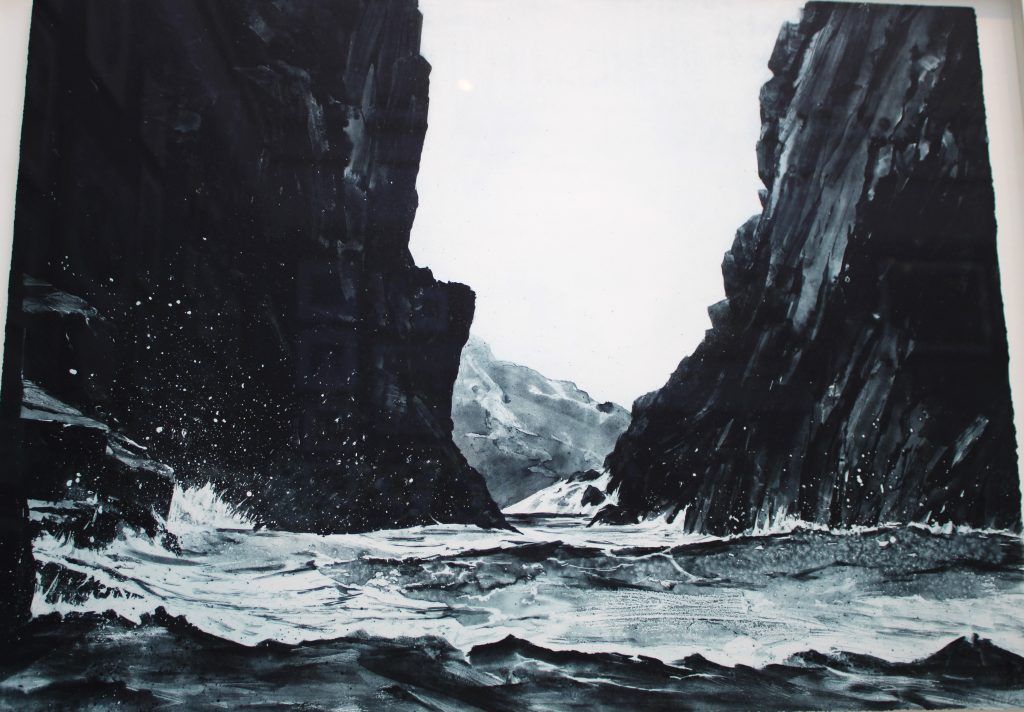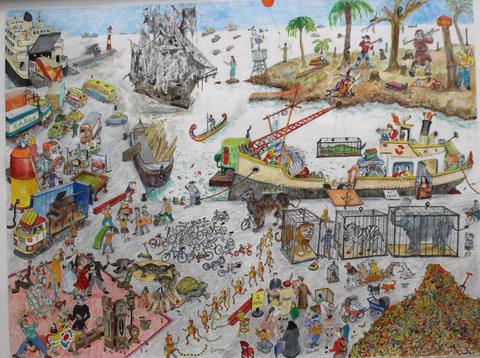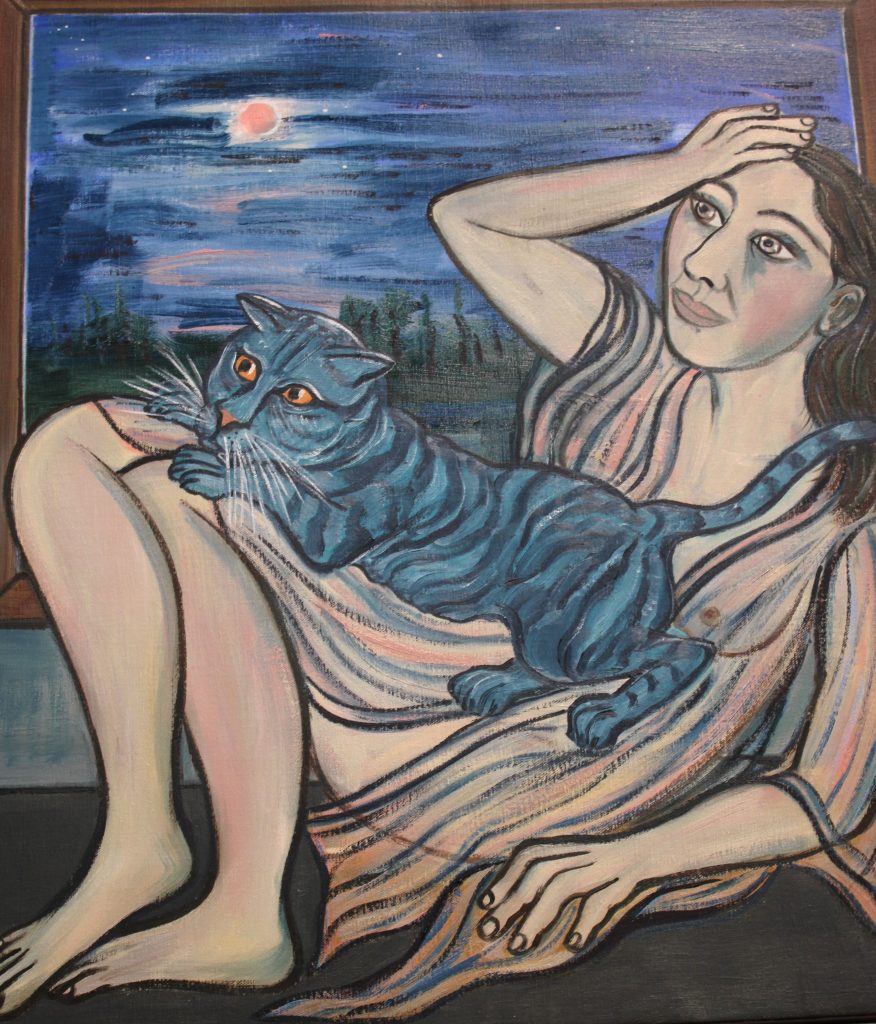
Royal Academy’s 2024 Summer Exhibition mixes the joy of art and splendour of nature By James Brewer
Setting sail for its 256th year, the Royal Academy Summer Exhibition 2024 launches 1,700 artworks in a unique and sprawling celebration of recent contemporary creativity.
The event, a platform and support for the artistic community, is a hodgepodge of the avant-garde and the cheeky (such as Peanut butter on toast, oil and acrylic on board, and Toilet Bowl Mould by Ideal Standard), with plenty of oceanic, animal and abstract inspirations. Alongside the many rehashes are new twists on familiar subject matter.
But the propositions most worth standing before in awe are breathtaking aspects of the power and vulnerability of nature. Dramatic landscapes include stunning large intaglio prints of polar regions presented by Emma Stibbon, who is senior lecturer in Fine Art at the University of Brighton. Her work with its scintillating light effects thrusts in front of our eyes the acceleration of climate change risk. Of Emma’s many photographic compositions, the exhibition is graced with those entitled Sea Swell, Spert Island, Antarctica; with Livingston Island, which is 120 km north of the Antarctic Peninsula; and, as the low northern light casts shadows of its dark, jagged rocks, Gjertsenodden, Svalbard, a location halfway between Norway and the North Pole.

On the Royal Academy website, Emma Stibbon is quoted as saying: “The polar regions are remote and disorientating landscapes where scale and distance confound the eye. Passing through this strange, ethereal light certainly felt like one was travelling into an internal world. I wanted the work to reflect a feeling of reverie or introspection.”

The Royal Academician records her observations through drawing, photography and film, which she resets into larger scale works in her studio. While on artist placement aboard HMS Protector, she documented in varying media aspects of the vast yet fragile environment of the Antarctic. As the Royal Navy was registering scenes with sophisticated digital equipment, she wielded traditional brush and ink.
The enduring subject of the sea hoves into sight in several of the rooms allocated to the exhibition. “The theme of boats and seascapes is timeless and yet remains pertinent as ever,” says the RA catalogue. Vessels are realised in unconventional materials such as plaster and encaustic wax. A watercolour on driftwood is made by Peter Mollett of the Seven Sisters Cliffs of East Sussex.
Joseph Ijoyemi’s fleet in a display case of origami boats, made of metal plates removed in 1963 from the hull of the clipper Cutty Sark, serves as a symbol of resilience of second-generation migrants from Africa choosing to return to their ancestral lands to rebuild and connect with their roots. Joseph, an Afro-Swedish artist living in London who has taken part in various group exhibitions, including at the National Maritime Museum, calls the piece Revival Boats.

London artist Chris Orr shows the latest of his intricate, cartoon-like ink-drawing and watercolours – measuring 76 x 102 cm, bearing the simple title, Cargo, and packed with figuration and incident. It is a follow-up to a previous painting entitled Ship and expounds on the multiplicity of freight that today’s maritime industry transports around the globe, and embraces a broader, ecological theme about exploitation. A container truck is being embarked and on the quayside is a miscellany of goods, including cages of wild animals – lion, zebra, elephant, crocodile – waiting to be shipped. The picture includes piles of fruit, a ballroom of dancing couples, a collection of cricket bats, bicycles, grandfather clocks and robots. Entering the harbour meanwhile is what the artist calls the “Black Freighter” a ghost ship. On a tropical isle nearby, axemen commit brutal de-forestation. Thus does Chris Orr live up to the description of being “a social surrealist.”
Veteran artist Norman Ackroyd, who is represented in many public collections, offers a selection of atmospheric seascape etchings of the wild Atlantic off the Irish coast.

The British sculptor Ann Christopher has co-ordinated this year’s exhibition and with the exhibition committee, they explore the ambiguous theme of making space – by which it seems is meant space for making, or for taking. Ann Christopher said: “To make space can mean openness – making space for something or someone, also making space between things. It is my belief that the spaces in between are as important as whatever those spaces separate.” Her aim was to create contrasts of small and large works, including the hanging of sculptures on the walls, and this has been skilfully realised by Sinta Berry, the managing curator of the exhibition.

Ann Christopher has transformed one of the galleries into an industrial warehouse with a mix of models, machinery and curious objects. Architecture is featured as always with works including Bronze Blobitechture, Before and After (Diptych) which is a pair of cast solid bronze pieces, one polished, one raw.
Just as fantasy as physical is The Quartet, a construction by industrial designer and sculptor Ron Arad of “a string quartet that plays itself.” Quite a montage built from wood, steel, copper, silicon, and cotton (and for sale at £300,000), it has everything but the visible presence of musicians. Four conventional string instruments are ‘seated’ on empty chairs and mysteriously ‘play to the gallery.’ The key to the trick is a resonator, a component usually found in speaker systems, installed on each instrument, converting signals from a laptop into frequencies that vibrate through the wood of the instruments. A renowned German luthier, Stefan-Peter Greiner, collaborated on the project.

In the incorporeal scene, Ron Arad references the Covid-19 era of musicians performing in halls without audiences and streaming their concerts over the Internet; in Quartet the empty chairs signify absent musicians. His brother, the accomplished violinist Atar Arad, composed a piece called Whims especially for the installation, and it was performed by a leading US-based ensemble, the Pacifica Quartet. The prolific Ron Arad works from a studio that is a converted dairy farm in Camden Town, London.
A miaow of fun is provided by A Teacake Cat, a collage by children’s book illustrator Paula Martyr, who is based in Bradford-on-Avon, Wiltshire. She uses wrappings from the Scottish teacakes made by Tunnock’s and recycles her picture frames from charity shop sales to keep things eco-friendly.
Turning to politics, a charcoal and conté work by Michael Sandle is entitled The Mass Slaughter of Defenceless Women & Children is not how You Deradicalise Gaza. His work challenges what Sandle describes as “the heroic decadence” of capitalism, particularly its appetite for global conflict. John Smith, an artist and filmmaker with a commonplace name but uncommonly sharp scorn for his targets, shows Plasticine Flag – an edition of five at £3,600 – which he says is simply “a Palestinian flag sculpted from unaltered lengths of coloured Plasticine.”
Back in relatively conventional territory, one of the most distinguished Royal Academicians, the earnest Eileen Cooper, displays several of her bold, expressionist portraits which are centred on the female conversance with the vicissitudes of love, and animals and mythology.
In the Royal Academy courtyard is a monumental textile sculpture by UK-based artist Nicola Turner who “investigates dissolution of boundaries, liminal states, and continuous exchanges across ecosystems.” It is made of found organic matter, including horsehair and wool, and is said to explore the intersection between life and death, amid which pops up a copy of the formal statue of the RA founding president, Sir Joshua Reynolds.

One of the founding principles of the Royal Academy of Arts was to “mount an annual exhibition open to all artists of distinguished merit” to finance the training of young artists in the Royal Academy Schools, and at this year’s opening Axel Rϋger, the RA secretary and chief executive, expressed his pride that funds raised – most works are for sale – support the exhibiting artists, the postgraduate students in the RA Schools and the work of the Royal Academy. The exhibition is the world’s largest open submission contemporary art show and has taken place every year without interruption since 1769. Royal Academicians are entitled to submit up to six works and the remainder of the show features people invited by the exhibition committee and external entrants.
Lead sponsor of the Summer Exhibition is global investment manager, London-based Insight Investment.
Epic in its scope but inevitably quixotic, in keeping with its tradition, the new summer exhibition will be regarded by many once they have adjusted to craning their necks to stare at entries hung high above the eye-line, as yet again a magnificent achievement.
The Royal Academy Summer Exhibition 2024 runs until August 18: open 10am – 6pm Tuesday to Sunday, except 10am – 9pm Friday.





